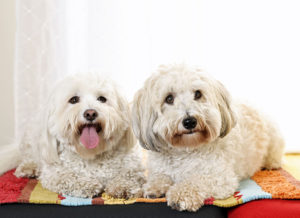Beyond Odd: Cloning Pets Is Harmful to Animals

When Variety published a cover story last month featuring legendary singer, actress, and filmmaker Barbra Streisand’s thoughts on her career and national politics, they could not have imagined the attention a casual paragraph about her dogs would get. In the interview, Streisand revealed that two of her three dogs are clones of Samantha, Streisand’s beloved Coton de Tulear who died last year. But fans and readers have reacted negatively to the news, asking the all-important question: Why?
Streisand tried to answer that question in a response published last week by the New York Times:
I was so devastated by the loss of my dear Samantha, after fourteen years together, that I just wanted to keep her with me in some way. It was easier to let Sammie go if I knew I could keep some part of her alive, something that came from her DNA.
When a beloved nonhuman animal dies, we go through the same stages of grief (denial, anger, bargaining, depression, and acceptance) that Elizabeth Kubler-Ross outlined in 1969. Studies show that grief is higher when there is a greater attachment to the animal and interest in the welfare of other animals, and when there is a lack support from other human animals. Oftentimes after a nonhuman used for companionship dies, we seek out a replacement animal as a substitute—looking for the same species, breed, markings, and even personality as the deceased. This response to grief is more similar to cloning than we’d like to admit.
Both expressions of grief are unrealistic, unfair, and disturbing. We try to avoid the mourning processes by placing the responsibility of our expectations on the “substitute” animal. Streisand told Variety: “They [the clones] have different personalities. I’m waiting for them to get older so I can see if they have her [Samantha’s] brown eyes and her seriousness.” But like finding another animal at a shelter or breeder that looks similar to the deceased, cloning can only replicate appearances, not personalities. Streisand might learn that the hard way.
While keeping animals for companionship is popular in cultures with plentiful resources and for individuals who can afford to keep animals that provide no other use to them but companionship, cloning is a whole new “luxury” for the upper class. According to Viagen Pets, a Texas-based company that provides dog and cat cloning services, cloning a single dog will cost over $50,000. Additionally, “pet-loving” consumers may not realize that clones aren’t born in a petri dish. Viagen Pet’s website gives no indication that anyone else’s life is impacted by the process. In reality, dozens of female dogs must undergo a surgical procedure while in heat to remove their eggs. Once the desired DNA is replaced by the unwanted original genetic material of the “donor” dogs and the eggs are fertilized successfully, they are surgically implanted into “surrogate” dogs who are then forced to carry the litter of clones to term.
Cloning deceased animals is another expression of control. Domesticity itself is the result of controlled breeding for human purposes. For thousands of years, we have forcefully influenced the shape, size, color, and temperaments of other species to suit our needs and preferences, even to their disadvantage. We’ve engineered Pugs to have severely restricted airways, German Shepherds to have misshapen legs, and even goldfish to have bulging eyes. This not only contorts companion animals to our aesthetic standards to the detriment of their health and longevity, it forces them to rely on us for their survival. And when we aren’t influencing their DNA, we castrate them, declaw them, remove their tails and vocal chords, and then we train them to be obedient. Cloning aside, we already control every aspect of their bodies.
Without a doubt, companion animals are special to us. We consider them members of the family, we buy them toys and clothes, take them everywhere with us, and we sincerely grieve their death. After they die we bury or cremate them, and some even believe that they go to a heaven-like place called the Rainbow Bridge. The prospect of losing a loved one is frightening, but inevitable. Streisand invested a lot of money in the illusion of cheating death, but in the process denigrated Samantha and her clones. In expecting another animal to act as a stand-in for a deceased companion, we cheapen our relationship with them and reinforce their socially constructed status as commodities. How can we feel comfortable simultaneously offering extraordinary love and care to companion animals, while at the same time stripping them of autonomy?
